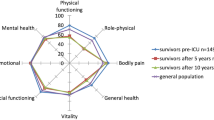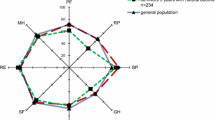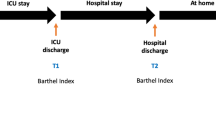Abstract
Objectives
To study health problems, quality of life, functional status, and memory after intensive care.
Setting
Adult patients (n=346) discharged from a university hospital ICU.
Design and methods
Prospective cohort study. Follow-up patients were found using the ICU database and the Peoples Registry. Quality of life (QOL) was measured with the Short Form 36 (SF-36) 6 months after ICU discharge. Semi-structured interviews, questionnaires, Glasgow Outcome Score (recovery), and Karnofsky Index (functional status) were used at consultations 7–8 months after ICU discharge.
Results
The SF-36 response rate was 64.5%, with scores significantly lower than population scores. Consultation patients (n=136) did not differ from the rest (n=210) regarding age, SAPS II scores, length of stay (LOS), and reasons for ICU admission. At follow-up 67.6% of consultation patients continued most activities, 75% looked after themselves, and 64.7% were non-workers, compared to 40.4% before the ICU admission. During and after the ICU stay, 40% lost more than 10 kg body weight. Fifty-eight (43%) could not remember anything from their ICU stay. At follow-up only 22 (16%) could remember having received information during their ICU stay. Three patients needed referral to other specialities.
Conclusions
We should focus more on optimizing symptom management and giving repeated information after ICU discharge. Nutritional status and weight loss is another area of concern. More research is needed to find out how the broad range of psychosocial and physical problems following an ICU stay relates to the stay.


Similar content being viewed by others
References
Eddleston JM, White P, Guthrie E (2000) Survival, morbidity, and quality of life after discharge from intensive care. Crit Care Med 28:2293–2299
Hurel D, Loirat P, Saulnier F, Nicolas F, Brivet F (1997) Quality of life 6 months after intensive care: results of a prospective multicenter study using a generic health status scale and a satisfaction scale. Intensive Care Med 23:331–337
Konopad E, Noseworthy TW, Johnston R, Shustack A, Grace M (1995) Quality of life measures before and one year after admission to an intensive care unit. Crit Care Med 23:1653–1659
Black NA, Jenkinson C, Hayes JA, Young D, Vella K, Rowan KM, Daly K, Ridley S (2001) Review of outcome measures used in adult critical care. Crit Care Med 29:2119–2124
Vazquez Mata G, Rivera Fernandez R, Gonzalez Carmona A, Delgado-Rodriguez M, Torres Ruiz JM, Raya Pugnaire A, Aguayo de Hoyos E (1992) Factors related to quality of life 12 months after discharge from an intensive care unit. Crit Care Med 20:1257–1262
Wehler M, Martus P, Geise A, Bost A, Mueller A, Hahn EG, Strauss R (2001) Changes in quality of life after medical intensive care. Intensive Care Med 27:154–159
Broomhead LR, Brett SJ (2002) Clinical review: Intensive care follow-up—what has it told us? Critical Care 6:411–417
Rundshagen I, Schnabel K, Wegner C, am Esch S (2002) Incidence of recall, nightmares, and hallucinations during analgosedation in intensive care. Intensive Care Med 28:38–43
Stein-Parbury J, McKinley S (2000) Patients’ experiences of being in an intensive care unit: a select literature review. Am J Crit Care 9:20–27
Rotondi AJ, Chelluri L, Sirio C, Mendelsohn A, Schulz R, Belle S, Im K, Donahoe M, Pinsky MR (2002) Patients’ recollections of stressful experiences while receiving prolonged mechanical ventilation in an intensive care unit. Crit Care Med 30:746–752
Jones C, Griffiths RD, Humphris G (2000) Disturbed memory and amnesia related to intensive care. Memory 8:79–94
Jones C, Griffiths RD, Humphris G, Skirrow PM (2001) Memory, delusions, and the development of acute posttraumatic stress disorder-related symptoms after intensive care. Crit Care Med 29:573–580
Hupcey JE, Zimmerman HE (2000) The need to know: experiences of critically ill patients. Am J Crit Care 9:192–198
Griffiths RD, Jones C (2002) Intensive care aftercare. Butterworth Heinemann, Oxford, pp 1–170
Brazier JE, Harper R, Jones NM, O’Cathain A, Thomas KJ, Usherwood T, Westlake L (1992) Validating the SF-36 health survey questionnaire: new outcome measure for primary care. BMJ 305:160–164
Ware J (1993) SF-36 Health Survey. Manual and interpretation guide. The health institute, Boston, Mass., USA
Jennett B, Bond M (1975) Assessment of outcome after severe brain damage. Lancet 1:480–484
Schag CC, Heinrich RL, Ganz PA (1984) Karnofsky performance status revisited: reliability, validity, and guidelines. J Clin Oncol 2:187–193
Cytel Software Corporation StatXact. Cambridge SC, USA, 1999
Dragsted L, Qvist J, Madsen M (1990) Outcome from intensive care. IV. A 5-year study of 1308 patients: long-term outcome. Eur J Anaesthesiol 7:51–62
Niskanen M, Kari A, Halonen P (1996) Five-year survival after intensive care—comparison of 12,180 patients with the general population. Finnish ICU Study Group. Crit Care Med 24:1962–1967
Zaren B, Bergstrom R (1989) Survival compared to the general population and changes in health status among intensive care patients. Acta Anaesthesiol Scand 33:6–12
Flaatten H, Kvale R (2001) Survival and quality of life 12 years after ICU. A comparison with the general Norwegian population. Intensive Care Med 27:1005–10011
Ridley S, Plenderleith L (1994) Survival after intensive care. Comparison with a matched normal population as an indicator of effectiveness. Anaesthesia 49:933–935
Ridley SA, Chrispin PS, Scotton H, Rogers J, Lloyd D(1997) Changes in quality of life after intensive care: comparison with normal data. Anaesthesia 52:195–202
Chrispin PS, Scotton H, Rogers J, Lloyd D, Ridley SA (1997) Short Form 36 in the intensive care unit: assessment of acceptability, reliability and validity of the questionnaire. Anaesthesia 52:15–23
Loge JH, Kaasa S (1998) Short form 36 (SF-36) health survey: normative data from the general Norwegian population. Scand J Soc Med 26:250–258
Brooks R, Kerridge R, Hillman K, Bauman A, Daffurn K (1997) Quality of life outcomes after intensive care. Comparison with a community group. Intensive Care Med 23:581–586
Holbrook TL, Anderson JP, Sieber WJ, Browner D, Hoyt DB (1999) Outcome after major trauma: 12-month and 18-month follow-up results from the Trauma Recovery Project. J Trauma 46:765–773
Pettila V, Kaarlola A, Makelainen A (2000) Health-related quality of life of multiple organ dysfunction patients one year after intensive care. Intensive Care Med 26:1473–1479
Chaboyer W,Foster M, Creamer J (2002) Health status of ICU survivors: a pilot study. Aust Crit Care 15:21–26
Zaren B, Hedstrand U (1987) Quality of life among long-term survivors of intensive care. Crit Care Med 15:743–747
Negro F, Cerra FB (1988) Nutritional monitoring in the ICU: rational and practical application. Crit Care Clin 4:559–572
Griffiths RD, Jones C (1999) Recovery from intensive care. BMJ 319:427–429
Schelling G, Stoll C, Haller M, Briegel J, Manert W, Hummel T, Lenhart A, Heyduck M, Polasek J, Meier M, Preuss U, Bullinger M, Schuffel W, Peter K (1998) Health-related quality of life and posttraumatic stress disorder in survivors of the acute respiratory distress syndrome. Crit Care Med 26:651–659
Scragg P, Jones A, Fauvel N (2001) Psychological problems following ICU treatment. Anaesthesia 56:9–14
Jones C, Humphris GM, Griffiths RD (1998) Psychological morbidity following critical illness—the rationale for care after intensive care. Clin Intensive Care 9:199–205
Backman CG, Walther SM (2001) Use of a personal diary written on the ICU during critical illness. Intensive Care Med 27:426–429
Hames KC, Gager M, Waldmann CS (2001) Patient satisfaction with specialist ICU follow-up. Br J Anaesth 87:372–373
Wilkins A, Koshy G, Waldmann CS (1998) Long-term outcomes of patients in ICU with multi-organ failure. Br J Anaesth 81:651
Author information
Authors and Affiliations
Corresponding author
Rights and permissions
About this article
Cite this article
Kvåle, R., Ulvik, A. & Flaatten, H. Follow-up after intensive care: a single center study. Intensive Care Med 29, 2149–2156 (2003). https://doi.org/10.1007/s00134-003-2034-2
Received:
Accepted:
Published:
Issue Date:
DOI: https://doi.org/10.1007/s00134-003-2034-2




